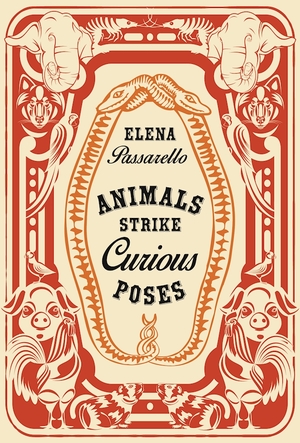Reviewed by Sarah Evans
 From the opening pages of Animals Strike Curious Poses (Sarabande Books, February 2017) — where a 21st-century hunter discovers a frozen woolly mammoth still woolly after spending millennia trapped in rock and ice — it’s clear that Elena Passarello hasn’t written a typical book about animals.
From the opening pages of Animals Strike Curious Poses (Sarabande Books, February 2017) — where a 21st-century hunter discovers a frozen woolly mammoth still woolly after spending millennia trapped in rock and ice — it’s clear that Elena Passarello hasn’t written a typical book about animals.
Cute or heartwarming tales about animal companionship are hard to find within these pages. Same goes for long, encyclopedic entries on creatures’ biology or familiar observations and reflections from the naturalist or environmentalist viewpoint.
No, not much about Animals— a book of 17 essays that recently earned the 2018 Oregon Book Award for Creative Nonfiction — could be called familiar. And that’s just what makes it so engrossing, so unforgettable, and one of the most fascinating books about animals that you’ll read.
Part of what makes Animals so unique is Passarello’s experimental writing style. The book is nonfiction, but the author pushes hard on the boundaries of the genre, using vastly different formats from essay to essay. In one, she writes in second person while imagining the perspective of Harriet, a 175-year-old tortoise purportedly picked up by Charles Darwin in the Galapagos Islands. In another, she recreates the missing half of a real poem written by Christopher Smart to his cat. In yet another, she takes apart an Australian student workbook passage on a man-eating crocodile and interweaves it with reflections on terrorism and animal naming.
This last point on naming is a major driver for the book. All the essays focus on animals that have been immortalized with human names; a few are quite famous, like Koko the gorilla and Mr. Ed the horse, while most are more obscure, or have been mostly forgotten. In “Osama,” the crocodile essay, Passarello posits her theory on why we often give human names to things of nature:
Names sink an unconquerable entity—a hurricane, a rogue virus, a man-eater—with the weight of a fresh, human-made label. … We doubt our ability to get inside the brain of an erratic and inhuman thing-of-the-world, like a monster storm or an epidemic. … So we name it, in hopes of yanking it from the chaos-machine in which it naturally thrives.
Passarello mixes biology, sociology, history, art, and literature, to not only tell the stories of her chosen animals, but to also connect them with the humans who knew and used — or often misused — them. In doing so, she provides thought-provoking reflections on how all of us interact with the creatures of our world. Often, the stories are heartbreaking, such as her recounting the years of abuse Americans heaped upon the first elephants that were brought to the U.S. Others instill newfound fascination and respect for particular species, such as her pondering of whether Mozart’s pet starling might have influenced the way he wrote music.
Passarello dove deep into researching these creatures to uncover the most fascinating or obscure tidbits about their lives, details that could potentially shed light on why they became important enough to earn human names, and what that says about human nature. Her command of literary storytelling, her captivating descriptions, and her philosophical ponderings, while often leaving more questions than answers, eventually make you want to do the same.
 Sarah Evans is an Oregon writer who has been published in Bluestem, Mom Egg Review, The Quotable, and on River Teeth Journal’s Beautiful Things blog and Brevity’s Nonfiction Blog. She earned an MFA in nonfiction writing from Pacific University. Read more about her at www.sarahevanswriter.com.
Sarah Evans is an Oregon writer who has been published in Bluestem, Mom Egg Review, The Quotable, and on River Teeth Journal’s Beautiful Things blog and Brevity’s Nonfiction Blog. She earned an MFA in nonfiction writing from Pacific University. Read more about her at www.sarahevanswriter.com.


